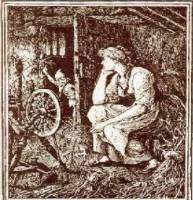
In this professional development session, participants will find connections between the principles of authenticity and the Marzano elements of Teacher Leader Effectiveness (TLE). This session does not address the other optional model known as the TULSA TLE Model. Read more »

This professional development session focuses on the components of authentic learning. The session is designed to have a minimum of eight participants. Participants will connect the components of authentic learning to a Rumpelstiltskin lesson and explore ways to make their own lessons more authentic... Read more »

The "Reading Realities: Using E-Readers to Engage and Support Students' Critical Reading Skills" professional development focuses on using Kindle e-readers and Google Expeditions to support student reading engagement. Research suggests that students are more eager to read when using an e-reader or mobile... Read more »

This professional development session is designed to help teachers employ effective instructional strategies to help students interact with and deepen new content knowledge. These strategies provide in-class opportunities where students can reflect on critical content through cognitively complex tasks.... Read more »
Target Audience
Calendar Placement
Group Size

This short professional development activity allows participants to interact with G Suite and the Explore button and identify its use in the classroom. Read more »
Target Audience
Calendar Placement
Group Size
Intention Or Purpose

The Leading Educators in Authentic Development (LEAD) workshop is a series of professional learning sessions that develop teachers’ skills in leading professional development at their school sites. This workshop features four sessions over a two-day period. This fourth session, Leading Educators in... Read more »
Target Audience
Calendar Placement
Group Size
Intention Or Purpose
Standards

In this professional development, participants explore elements of student engagement and examples of positive classroom culture. Next, they participate in a variety of engaging instructional strategies as learners and gain experience modifying and/or scaffolding these strategies to support their own... Read more »
Target Audience

The Leading Educators in Authentic Development (LEAD) workshop is a series of professional learning sessions that develop teachers’ skills in leading professional development at their school sites. This workshop, which builds on four previous workshops, features two sessions over a one-day period. This... Read more »
Target Audience
Calendar Placement
Group Size
Intention Or Purpose

In this session, participants will examine their understanding of family engagement and reflect on past Family Leadership Academy (FLA) efforts to identify areas of strength and improvement. They will explore the impact of increased family participation on student success and school culture, and they... Read more »

Students will activate prior knowledge and make connections to the post-WWII era in America by looking at images from the time period. In addition, students will read poems that depict contrasting points of view from the decade (the point of view of an American versus a Holocaust survivor resettled... Read more »
Characterization
Subject
Grade Level
Standards

Students will explore what happens when one measures a "rough" object using different units of measure. This lesson is adapted from Benoit Mandelbrot's famous problem, "Measuring the Coastline of Britain." Students will learn about the concepts of convergent and divergent series and the paradoxical... Read more »
Convergent and Divergent Series
Grade Level
Course
Subject
Standards

This two-part lesson includes a variety of pre-reading activities to prepare students to actively read Shakespeare's tragedy, "Othello." Students first rely on prior knowledge as they research Shakespeare as a playwright and his writings in a K-W-L activity. Then, they consider theme statements from... Read more »
Pre-Reading Strategies
Grade Level
Subject
Course
Standards

This lesson continues to develop an understanding of fractions and builds a foundation for understanding the addition of fractions. Students engage in thoughtful mathematical conversations and use manipulatives to prove their thinking. Read more »
Fractions
Course
Subject
Grade Level
Standards

The lesson examines the structure and jurisdiction of the federal court system as explained through Article III of the Constitution. Through playing a Jeopardy game and watching a video, students learn more about the structures, powers, and responsibilities of the Supreme Court and the lower federal... Read more »
Judicial Branch
Grade Level
Subject
Course
Standards

This lesson explores DNA fingerprinting and how it relates to paternity (or familial) tests and police investigations. After talking about what DNA fingerprinting is and what it covers, students will read an article to decide whether they agree or disagree with the practice of DNA fingerprinting in... Read more »
DNA Fingerprinting and Profiling
Grade Level
Course
Standards

This lesson is part of a series, titled "Woman Crush Wednesday" in which we look at how female scientists have shaped our view of science. In this biology lesson, students will explore the contributions of Rachel Carson, the impact of human activity on our ecosystem, and how organisms develop resistance... Read more »
Biological Unity and Diversity
Subject
Course
Grade Level
Standards

This lesson aims to help students develop an understanding of zoonotic diseases. In this lesson, students will explore how zoonotic diseases spread. Read more »
Zoonotic Diseases
Subject
Course
Grade Level
Standards

Students will track how inflation has altered the cost of living from 1920 until today by examining vintage advertisements for various goods. Students will also learn how inflation continues to have an effect on the U.S. economy by watching a couple of videos and designing anchor charts. Read more »
Inflation and Cost of Living
Grade Level
Subject
Course
Standards

In this lesson, students explore the theme of tradition by reading Shirley Jackson’s short story, "The Lottery," and an accompanying article, "The Dangers of Tradition." As students develop their own beliefs concerning the value and possible dangers of tradition, they share their opinions with their... Read more »
The Lottery
Subject
Course
Grade Level
Standards

Using a Growing Pattern to Solve a Problem
Grade Level
Cumulative stories such as "One Duck Stuck" can illustrate mathematical growing patterns. In this lesson, the story shows how the number increases by one as animals come to help rescue the duck from the muck. As the growing pattern is revealed through the story, children get excited because they cannot... Read more »
Using a Growing Pattern to Solve a Problem
Grade Level
Subject
Standards

This lesson uses Lawrence Kohlberg's Heinz Dilemma to teach students how to create an effective argument using evidence and logical reasoning. Content is introduced with an anticipation guide and class discussion. Students then read and respond to the Heinz Dilemma and analyze four claims, then create... Read more »
Examining Argument Through a New Lens
Related
Subject
Course
Grade Level
Standards

In this interactive lesson, students engage with their peers by taking a stance on a topic and providing reasoning that supports their opinion. Then students read through a series of persuasive essays, identifying and discussing the persuasive elements found in the essays. Students then write their... Read more »
Persuasive Writing
Grade Level
Subject
Related
Course
Sponsor
Standards

How do women entrepreneurs overcome barriers to success in the business world? This lesson examines the challenges and triumphs of notable female business leaders. Students will engage in collaborative inquiry, beginning with an iCAP video featuring successful Oklahoma businesswomen. They will identify... Read more »
Women in Business
Related
Grade Level
Course
Standards

In this lesson, students compare methods to evaluate numerical expressions with and without the use of a non-scientific calculator. Students begin by discussing the pros and cons of modern technology. They then explore the limitations of a non-scientific calculator when using one to evaluate numerical... Read more »
Order of Operations
Grade Level
Course
Subject
Standards

"At the table, we don't just share food, we share memories." Students will connect their understanding of punctuation rules with analyzing and writing food blogs. The knowledge gained through the previous lessons in this collection will enable students to identify successfully how punctuation impacts... Read more »
Punctuation Culmination
Grade Level
Subject
Course
Related
Standards

Students explore the benefits of working in a group with different viewpoints and reflect on their own work preferences and how they shape the ways they contribute to group work. Read more »
Target Audience
Calendar Placement
Group Size
Intention Or Purpose
College & Career Readiness Framework

Students will listen to an engaging speech and record their thoughts. Students will then choose a topic of their interest and write down all they know about the topic in a two-minute paper. Students will learn more about preparing a speech and discuss their learning with their peers. They will create... Read more »
Calendar Placement
Group Size
Intention Or Purpose
College & Career Readiness Framework
Related

